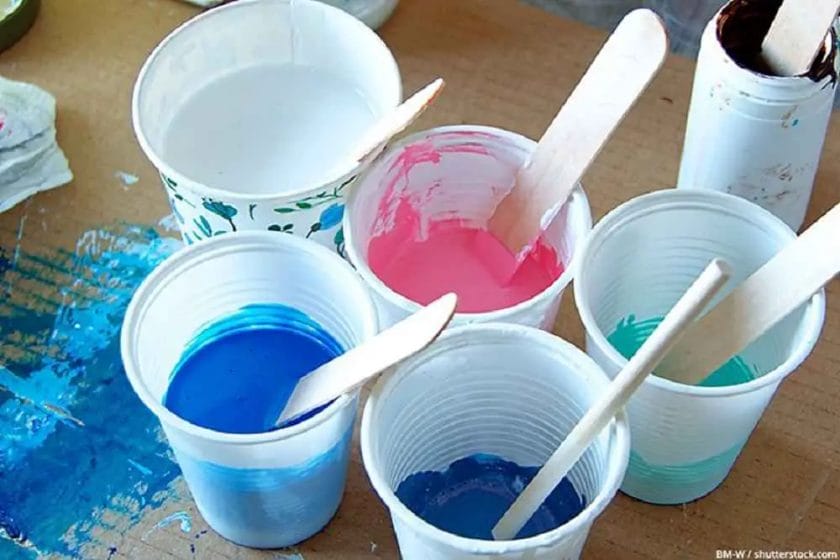Acrylic paint is a popular medium among artists and hobbyists alike, offering a range of unique characteristics and benefits.
When it comes to painting, understanding how to properly mix water with acrylic paint is crucial to achieving the desired result.
This article will provide a comprehensive guide on the topic, so that you can understand the properties of acrylic paint and whether you can mix water with acrylic paint or not.
Properties of Acrylic Paint
Acrylic paint is a fast-drying, water-soluble paint that is made from pigment, binder, and water. Its unique properties make it a versatile medium that can be used for a wide range of applications, from fine art to decorative painting.
Advantages and Disadvantages of Using Acrylic Paint
One of the biggest advantages of acrylic paint is its quick drying time, which allows for faster turnaround times in painting projects.
Additionally, acrylic paint can be thinned with water but is water-resistant once dry, making it easy to clean up and ideal for outdoor painting.
However, acrylic paint can sometimes dry too quickly, making the paint difficult to blend and manipulate .
Can I Mix Water With Acrylic Paint?
Yes, you can mix water in acrylic paint to thin it. However, you must do this with caution and always test the thinned acrylic paint on a small area first.
We recommend that you only mix up at most 10 parts of water with a part of acrylic paint though you may add more water depending on the consistency.
Understanding the Role of Water in Acrylic Paint
Water plays a crucial role in the mixing and application of acrylic paint. When mixed with water, acrylic paint becomes more fluid and easier to manipulate, allowing for a range of techniques and effects that would not be possible with paint straight from the tube.
However, it is important to understand the right ratio of water to paint, as too much water can dilute the paint and affect its opacity and drying time.
Mixing Water with Acrylic Paint
Reasons for Mixing Water with Acrylic Paint
There are several reasons why an artist might choose to mix water with acrylic paint, including:
- To thin the paint for a more fluid and transparent application
- To create a wash or glaze
- To adjust the consistency of the paint for easier blending and manipulation
- To extend the paint for a more cost-effective use
The Right Ratio of Water to Acrylic Paint
The correct ratio of water to acrylic paint will depend on the desired effect and application. As a general rule, a 1:1 ratio of water to paint is a good starting point for most techniques, but this can be adjusted as needed.
For a thin and transparent wash, a higher ratio of water to paint may be necessary, while for a thicker, more opaque application, a lower ratio of water to paint may be used.
Like stated above, you should only mix up at most 10 parts of water with a part of acrylic paint though you may decide to add more water depending on the level of consistency you want to achieve.
Tips for Mixing Water with Acrylic Paint
When mixing water with acrylic paint, it is important to use distilled water to prevent impurities from affecting the paint.
Additionally, it is best to mix the paint and water gradually, adding small amounts of water at a time until the desired consistency is achieved.
It is also helpful to mix the paint and water on a palette or mixing surface rather than directly in the paint tube to ensure accurate measurements.
The Effects of Over-Mixing or Under-Mixing
It is important to avoid over-mixing or under-mixing the paint and water, as this can have significant effects on the final result. Over-mixing the paint can result in a diluted, watery paint that lacks opacity and dries too quickly.
Under-mixing the acrylic paint can result in a thick consistency and difficult-to-manipulate paint. To avoid these issues, it is important to follow the recommended ratios and to mix the paint and water gradually and carefully.
Applications of Water-Mixed Acrylic Paint
Use Water-Mixed Acrylic Paint for Thin Layers and Glazes
By thinning the paint with water, artists can create thin layers and glazes that allow the underlying colors and textures to show through. This can be used to create a range of effects, from soft and translucent washes to more dramatic and layered textures.
Use Water-Mixed Acrylic Paint for Washes
Washes are a common technique used in watercolor and acrylic painting, and they involve applying a thin and transparent layer of paint over a surface.
When water is added to acrylic paint, it becomes easier to create wash-like effects, allowing for a more fluid and controlled application.
Use Water-Mixed Acrylic Paint for Toning and Blending
By adjusting the consistency of the paint with water, artists can use water-mixed acrylic paint to create tonal effects and blend colors smoothly and seamlessly.
This can be useful for creating a range of effects, from soft and subtle transitions to more dramatic and striking blends.

Drying and Handling Water-Mixed Acrylic Paint
Understand the Drying Time of Water-Mixed Acrylic Paint
The drying time of water-mixed acrylic paint will depend on the ratio of water to paint, as well as environmental factors such as temperature and humidity.
Generally, water-mixed acrylic paint will dry more quickly than paint straight from the tube, but it is still important to allow sufficient time for the paint to dry completely before handling the painted surface.
Tips for Handling Water-Mixed Acrylic Paint
When handling water-mixed acrylic paint, it is important to use appropriate brushes and tools to avoid damaging the painted surface.
Additionally, it is best to avoid over-brushing or re-wetting the paint once it has begun to dry, as this can cause the paint to lift or crack.
Avoiding Common Mistakes When Working with Water-Mixed Acrylic Paint
One of the most common mistakes when working with water-mixed acrylic paint is not allowing the paint to dry completely before handling the painted surface.
Additionally, it is important to avoid over-mixing or under-mixing the paint and water, as this can affect the opacity and drying time of the paint.
To ensure the best results, it is important to follow recommended ratios and techniques and to allow sufficient time for the paint to dry before handling the painted surface.

Conclusion
In conclusion, understanding how to properly mix water with acrylic paint is a crucial aspect of painting with this medium.
By following the recommended ratios and techniques, artists can create a range of effects and techniques, from thin and translucent layers to bold and dramatic blends.
With the right approach and attention to detail, artists can unlock the full potential of acrylic paint and create stunning and unique works of art.
How much water should I add to the acrylic paint?
The amount of water you add to acrylic paint can vary depending on your desired consistency and effect you want to achieve.
As a general rule, it’s recommended to start with small amounts of water and gradually increase the amount until you reach the desired consistency. It’s best to use a measuring cup or dropper to ensure precise measurements.
Can I mix water with acrylic paint to create a specific color?
Yes, you can mix water with acrylic paint to adjust the color intensity, but it’s recommended to use acrylic paints specifically designed for color mixing for best results.
Mixing water with acrylic paint can also affect the pigments in the paint, resulting in a change in the color.
Can I use tap water to mix with acrylic paint?
Yes, you can use tap water to mix with acrylic paint, but it’s important to keep in mind that tap water can contain minerals and impurities that can affect the consistency and performance of the acrylic paint.
However, it’s recommended to use distilled water or water specifically designed for painting purposes to ensure the best results.
Is it okay to add more water to acrylic paint once it has begun to dry?
No, it’s not recommended to add more water to acrylic paint once it has begun to dry.
Adding water to acrylic paint that has started to dry can cause the paint to lift or crack, affecting the overall appearance of the painting. It’s best to avoid over-brushing or re-wetting the paint once it has started to dry.
Can I use water-mixed acrylic paint for outdoor painting projects?
Yes, you can use water-mixed acrylic paint for outdoor painting projects, but it’s important to choose a high-quality, water-resistant acrylic paint that is specifically designed for outdoor use.
Water-mixed acrylic paint can be susceptible to fading and weather damage if not protected properly, so it’s best to use a clear, UV-resistant varnish to protect the painted surface from fading and other environmental factors.
